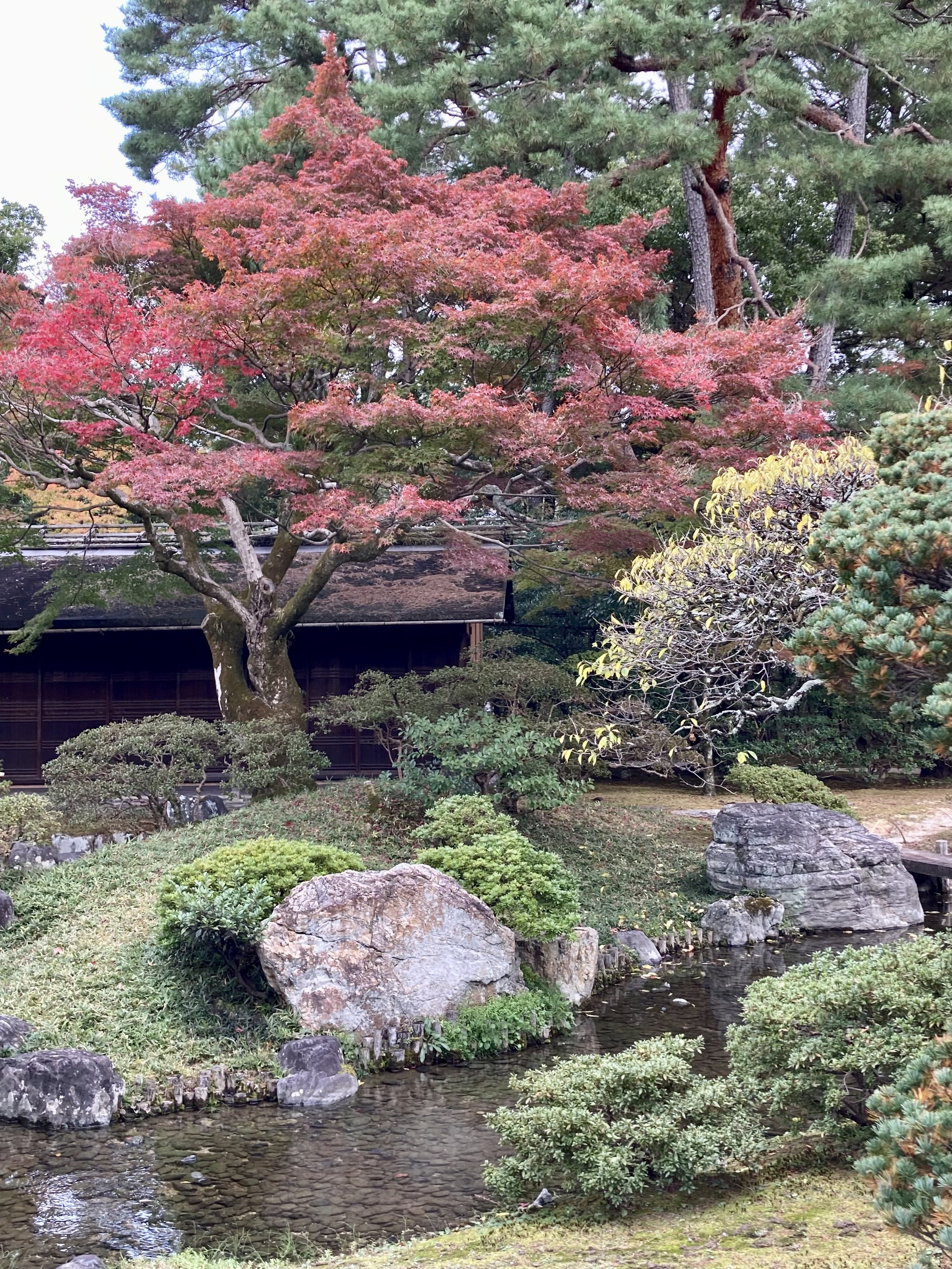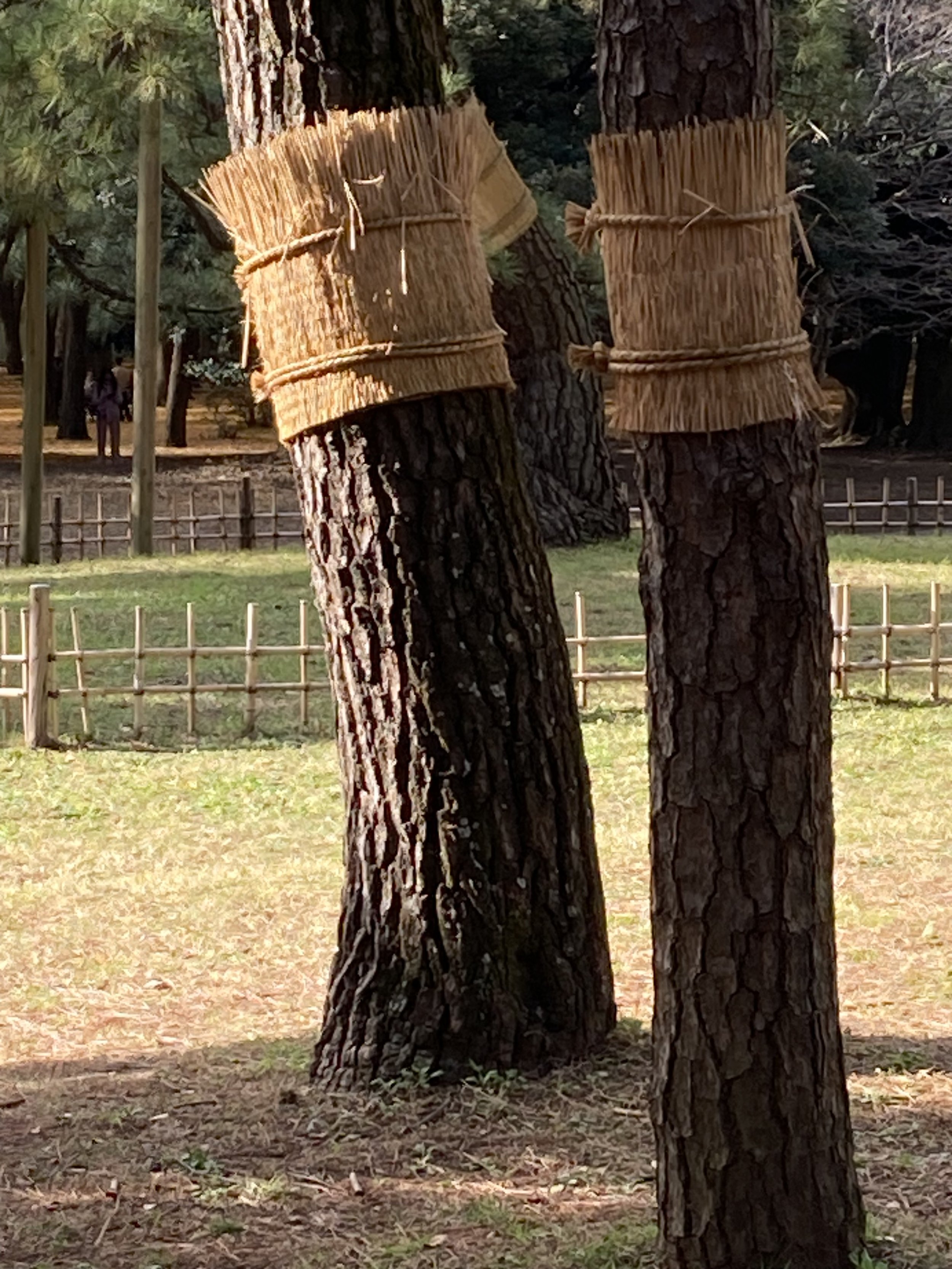Kenrokuen Garden, Kanazawa - J. Cook photograph
Japanese gardens are so unlike Western gardens that I find that one gazes at them with a mixture of delight and acute awareness of one’s ignorance. Layers of history and symbolism impress, their quietude and exquisite balance inspire an impulse just to sit and absorb each plant, each stone, each wonderfully placed tree or shrub, each mirroring pool.
Their varied historical developments date back to the 6th and 7th century, mainly on the main island of Honshu, where the diverse and well-watered vegetation married well with the indigenous very early polytheistic and animistic Shinto religion which had absorbed Buddhism after its arrival in Japan from the 4th century onwards. Both beliefs lent themselves to the veneration of trees, rocks and beaches. Shinto temples were soon surrounded with white pebbles or stones, signifying purity.
Eikando Nanrin-ji, Kyoto, J Cook photograph
Thus early Japanese gardens in the Heian period were often created around water, flowing or in lakes, with stones on the verges – the whole representing the landscape in miniature, influenced by the Buddhist beliefs about the five mountainous islands inhabited by the Eight Immortals who lived in perfect harmony with nature. Religion and nature united seamlessly, with a dash of pleasure for good measure for the emperor and his court in their gardens, with pleasure boating and picnics by the lakeside in beautiful surroundings. Temple gardens also embellished their buildings, using the same garden concepts.
Heian Shrine, Kyoto, a 19th century recreation of earlier gardens. J. Cook photograph
Hōnen-in temple, Kyoto. J. Cook photograph
Kyoto Imperial Palace. J. Cook photograph
Kyoto Imperial Palace. J. Cook photograph
Kyoto Imperial Palace. J. Cook photograph
Ryoanji Temple garden, Kyoto. J. Cook photograph
Alas, as we are constantly reminded in our own times, even paradise falls apart and wars destroy any civilised achievements. Japan was no exception, and from the 12th century onwards, constant civil wars between the emperors and their feudal warlords devastated the country. Kyoto or Heian-kyō (the peaceful capital), the Imperial capital, was the site of many extraordinary temples surrounded by water or rock gardens, many now influenced by an infusion of Zen influences through renewed contacts with China, However, the wars were not kind to many of its gardens as wooden temples were all too easy to burn.
Ryoanji Temple, perhaps the most famous Zen rock garden in Kyoto, Japan - 15th century. J. Cook photograph
Ryoanji Temple, J. Cook photograph
Ryoanji Temple, J. Cook photograph
Nonetheless, temples were rebuilt and meanwhile, the ruling daimyo, or heads of the feudal clans, wanted their own splendid gardens, with one-upmanship very apparent. Ponds or lakes were created artificially, designed to be viewed from above in their castles, with large stones placed carefully at the verges and on the adjacent land. Since they had abundant manpower with their individual armies, everything was possible. Interestingly, during that same Monoyama period (1568-1600), the counterpoint development was the often green moss small garden surrounding the deliberately humble structure for a tea house.
Nijo-jo Castle, Kyoto, home of the first Edo period shogun. J. Cook photograph
Nijo-jo Castle, Kyoto, J., Cook photograph
Outside the tea house at Shoden Eigen-in Temple, Kyoto. J. Cook photograph
As Japan moved into the Edo period, true power moved to Tokyo with the Tokugawa clan and its shogun. Kyoto remained the cultural and religious centre of the titular-only emperors – which left them free to build very simple elegant palace structures and create gardens. They mainly were of two types – promenade gardens which borrowed distant scenery to enhance them, or dry gardens. Since many rocks, chosen with enormous care and reverence over the centuries for their shape, colour and thus symbolism, were all that remained after the vicious civil strife, often with extra marks from the actual warfare, these now were often incorporated into the Zen rock gardens. The design of a Japanese rock garden does not require large spaces, and their treatment, with raked stones and carefully placed rocks in the “sea” of stones, was designed to evoke natural scenery and nature as it is truly seen.
Eikando Nanrin-ji, Kyoto, J Cook photograph
Kenninji Zen Temple, Kyoto. J. Cook photograph
Kenninji Zen Temple, Kyoto. J. Cook photograph
A modern rock garden at Hōnen-in Temple, Kyoto. J. Cook photograph
Some of the most famous rock gardens are perfect examples of how the quintessentially Japanese concept of the Zen silent contemplation and emptied mind fits perfectly into this deceptively simple natural space where negative emptiness and positive elements – stones, the solitary bush or tree, for instance – reign supreme. These gardens are places of receptive spirit, with nothing assertive nor intrusive in them. No wonder even bustling tourists slow down, sit on the wooden steps of a temple and quieten to contemplate these astonishingly powerful gardens. The intimate courtyard gardens at temples, such as Nanzen-ji in Kyoto, are an integral whole with the buildings, themselves so devoid of furniture, with rice or rush straw tatami floor coverings. The ensemble of garden and monastery building become a seamless transition to the wider natural world, where inside and outside are a cosmic whole.
Nanzen ji temple, Kyoto
Ginkaku-ji Silver Pavilion, Kyoto. J. Cook photograph
Quite apart from the history, the symbolism and the sheer beauty of gardens in Japan, their care and maintenance is impressive beyond impressive to a Westerner’s gardener’s eye. Pine trees shaped by centuries of patient pruning, heavy limbs supported and wires, almost Maypole structures, prepared to protect the trees from heavy winter snow, meticulous sweeping of leaves from paths in autumn using branches and twigs bound as brooms, plaited rice straw ropes circling important trees (a Shinto custom too)… all these measures bespeak of care, reverence and deep knowledge.
Care of an ancient tree at Ginkaku-ji Temple. J. Cook photograph
Beautifully shaped pine trees at the Kyoto Imperial Palace. J. Cook photograph
Pine Trees, Yoyogi Park, Kyoto. J. Cook photograph
Tree support, Heian Shrine, Kyoto. J. Cook photograph
Winter protection preparations, Kenrokuen Garden, Kanazawa. J. Cook photograph
One aspect of Japanese gardens which is familiar to Western gardeners is the concept of borrowed landscapes. Your garden forms the frame to view beyond and enhance the viewer’s enjoyment. Obviously, gardens on slopes have an easy advantage in that case, but nonetheless, again, seeing examples in Japan left one in deep admiration, especially with their wondrous use of foliage at all times of the year.
Ōkōchi Sansō Villa Garden, Kyoto, a viewing platform. J. Cook photograph
Jojakkoji Temple, on the slopes of Mount Ogura, Kyoto. J. Cook photograph


























